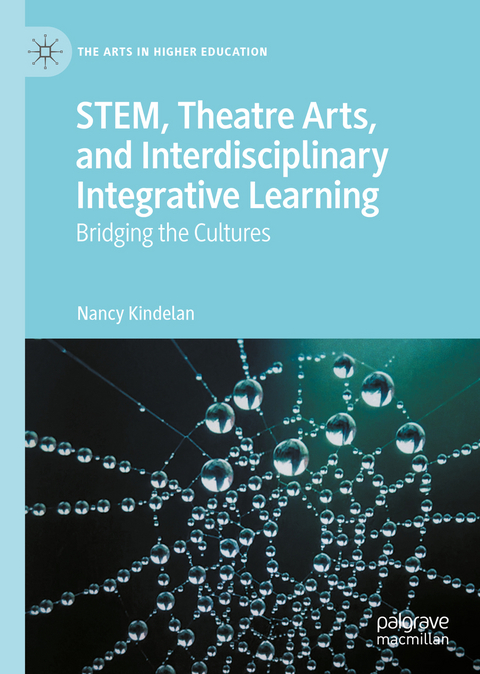
STEM, Theatre Arts, and Interdisciplinary Integrative Learning
Springer International Publishing (Verlag)
978-3-031-08906-0 (ISBN)
Nancy Kindelan is Professor Emerita of Theatre at Northeastern University, Boston, USA, where she taught numerous interdisciplinary courses, honors courses, performance classes, and script analysis and directed plays. Her books include Shadows of Realism: Dramaturgy and the Theories and Practices of Modernism (1996) and Artistic Literacy: Theatre Studies and a Contemporary Liberal Education, which received a Special Honorable Mention for the Outstanding Book Award from the Association for Theatre in Higher Education in 2013. She is the founding editor of the Palgrave Macmillan book series The Arts in Higher Education.
1 Introduction: Why Include Theatre Arts in New Modes of Undergraduate Education?.- References and Suggestions for Further Reading.- 2 Meeting the Challenges of Shifting Education Paradigms.- Introduction.- Greater Expectations, AAC&U's Essential Learning Outcomes, and Principles of Excellence.- Educational Practices.- Integrating STEM with the Humanities and Arts.- Conclusions.- References and Suggestions for Further Reading.- 3 Let's Get Started.- Introduction.- Liberal Arts, Liberal Education, and General Education.- Why Integration and What Is It?.- STEM, STEAM, and SHTEAM.- Other Examples of Integration (STS, STIRS, and STEMM).- Modes of Learning: Multidisciplinary, Interdisciplinary, Transdisciplinary, Integrative, and Applied.- Transformative Learning.- Factoring in Implementation.- Conclusions.- References and Suggestions for Further Reading.- 4 Enhancing Learning Through Integrative Education: On the Road.- Introduction.- Learning in the Digital Age.- Integrative Learning: Signature Work and Capstones.- The Whole Is Greater than the Sum of Its Parts.- Disciplinary Knowledge Versus Interdisciplinary Connections.- Additional Roadblocks.- The Road Ahead.- From the Inside Looking Out.- A Call to Action.- Conclusions.- References and Suggestions for Further Reading.- 5 Bridging the Gap Between STEM and Theatre Arts.- Introduction.- Theatre Arts Programs and the Theatre Practitioner.- Signature Pedagogies.- The Theatre Practitioner.- The Scientist.- The Mathematician.- The Engineer.- The Scientist, the Mathematician, the Engineer, and the Theatre Artist.- Liminal Spaces.- The Artistic Paradox: Humanism Versus Practicality.- Conclusions.- References and Suggestions for Further Reading.- 6 The Marriage of Disparate Disciplines.- Introduction.- Bridging the Gap Between Theatre and STEM.- The Artist as Scientist and the Scientist as Artist.- Leonardo da Vinci and Johann Wolfgang von Goethe.- Collaborative Partnerships.- Conclusions.- References and Suggestions for Further Reading.- 7 The Creative Spirit.- Introduction.- What Is Creativity?.- Where Is Creativity?.- Can Creativity Be Taught?.- Crossing Boundaries: Myths, Misconceptions, and Labels.- The New Frontier: "ArtScience" Collaborations.- Creative Pathways.- The Practice of Making.- Design Thinking and Systems Thinking.- Conclusions.- References and Suggestions for Further Reading.- 8 Facing the Creative Imperative.- Introduction.- Decoding the Disciplines.- More About Decoding.- Unpacking the Language, Strategies, and Creative Process in Theatre Arts.- No Muses on Stage Please.- Beyond "Soft Skills".- Toward Effective Storytelling.- What Is an Imagistic Analysis?.- Practicing the Art of Creativity in Theatre.- Teasing Out Similarities.- Divergent and Convergent Thinking.- Various Positions on the Scientific Method.- Sharing Creative Practices: Engineering and Theatre.- Social and Professional Skills.- Walking the Walk.- Sitting at the Table of Curriculum Reform.- Conclusions.- References and Suggestions for Further Reading.- 9 Answered and Unanswered Questions.- Introduction.- Making the Case.- Looking Forward.- The Players and the Process.- Questions, Concerns, and Suggestions for Further Research.- References and Suggestions for Further Reading.- Appendix V1: Good Questions: Drawing on Theater to Educate Reflective Engineers as Civic Participants, by Alison Wood.- Appendix V2: Constructing and Performing the Self: An Interdisciplinary Course That Transforms Scholars and Selves, by Jonathan M. Adler.- Appendix V3: Contemplating Science: A New Educational Paradigm for Interdisciplinary and Integrative Learning in Engineering, by Yevgeniya V. Zastavker and Madhvi J. Venkatesh.- Appendix V4: Theater Brings Community Voice to Bear on Wicked Problems, by Sarah A. Brownell.- Appendix V5: The Three-Year Theatre Engineering Capstone Experience: Scaffolding the Integration of Theory and Practice, by Rich Dionne.- Appendix V6: Portfolios That Build Community, by Leigh Witek.- Appendix V7: Going Beneath, by Lance Gharavi.- Appendix V8: Transdisciplinary and Multimodal Live Performance Research and Integration into the Curriculum, by Daniel Fine.- Appendix V9: Data Theatre, by Rahul Bhargava.- Appendix V10: Mechanics Meets Metaphor: An Interdisciplinary Web, by Liam Hofmeister.- Appendix V11: A Heart-Brain Connection: What Giraffes Taught Me About Science and the Arts, by Virginia Anderson.- Appendix V12: Reflections, by Shane L. Collins.- Appendix V13: Catalyst Collaborative@MIT: Pictures of Practice, by Debra Wise.- Biographies.- Index.
| Erscheinungsdatum | 05.10.2022 |
|---|---|
| Reihe/Serie | The Arts in Higher Education |
| Zusatzinfo | XXII, 338 p. 18 illus., 16 illus. in color. |
| Verlagsort | Cham |
| Sprache | englisch |
| Maße | 148 x 210 mm |
| Gewicht | 596 g |
| Themenwelt | Kunst / Musik / Theater ► Theater / Ballett |
| Sachbuch/Ratgeber ► Sport ► Tanzen / Tanzsport | |
| Sozialwissenschaften ► Pädagogik ► Erwachsenenbildung | |
| Sozialwissenschaften ► Pädagogik ► Schulpädagogik / Grundschule | |
| Schlagworte | applied learning • Creativity • cross-curriculum • integrative learning • learning outcomes • Steam • STEM Education |
| ISBN-10 | 3-031-08906-5 / 3031089065 |
| ISBN-13 | 978-3-031-08906-0 / 9783031089060 |
| Zustand | Neuware |
| Haben Sie eine Frage zum Produkt? |
aus dem Bereich


